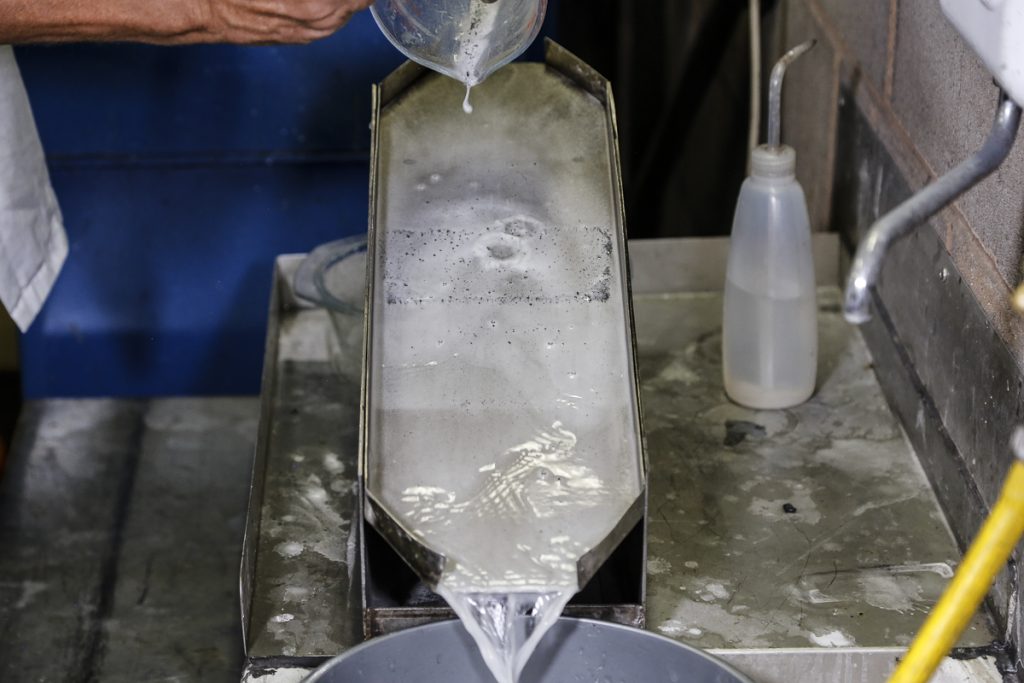Chute Magnet Separator Checks Magnetic Susceptibility
By Paul Fears | 07 December 2020
The Chute Magnet Separator or Magnetic Slide is a simple but important laboratory-scale wet magnetic separator for any material test facility. This magnetic test equipment enables the assessment of a particle’s magnetic susceptibility, which provides the platform for further tests on specific wet magnetic separators.

Wet magnetic separation techniques are employed when processing slurries (i.e. the process includes wet ball mills or flotation), or when the fine particle size dictates a wet processing route.
- Technical Product Information: Laboratory-scale Magnetic Separators
The Chute Magnet Separator mimics a Wet Drum Magnetic Separator and features a sloping stainless-steel chute positioned over a permanent Barium Ferrite Plate Magnet. The Plate Magnet generates between 400 and 600 Gauss on the surface of the chute. This level of magnetic field captures ferro-magnetic particles including magnetite, ferro-silicon, iron-scale, and abraded tramp metal from processing plant. The Chute Magnet Separator is not suitable for separating paramagnetic minerals.
- Technical Product Information: Wet Drum Magnetic Separators
Chute Magnet Separator in Operation
In operation, a slurry is fed down the chute with magnetic particles being held onto the surface whilst non-magnetic particles continue to flow into a collection receptacle. To recover the magnetics, the chute is hinged up and away from the Plate Magnet, washed off the chute with water, and collected in a separate container.
The most common users of the Chute Magnet Separator include mineral processing and recycling test facilities and universities. Testing on the Chute Magnet Separator commonly occurs prior to tests on a high-intensity magnetic separator (e.g. Electromagnetic Filter) to assess the content of strongly magnetic particles. When such magnetically strong particles enter a high-intensity magnetic separator, they block the matrix and significantly compromise the separation performance of weakly magnetic particles.
Checking Wet Drum Magnetic Separator Performance
In coal processing and heavy media plants, where Wet Drum Magnetic Separators recover the media such as magnetite and ferro-silicon, regular tests on the Chute Magnet Separator identify the relative performance of the magnetic separators. An increased level of magnetite or ferro-silicon in the slurry post-magnetic separation is indicative of a drop in performance of the Wet Drum Magnetic Separators, commonly remedied with simple adjustments.
Chute Magnet Separators are also used in the water treatment sector to assess the level of magnetics in a water supply.
The Chute Magnet Separator is part of Bunting’s extensive range of laboratory-scale magnetic separators.
Related Mineral Processing Technical Articles
Magnetic Separators – Mineral Processing Laboratory
Bunting-Redditch has one of the most comprehensive magnetic separation mineral processing testing laboratories in the world. Their Laboratory Technicians have decades of experience in mineral processing. Controlled tests ensure that the most suitable and cost-effective machinery is recommended for each application. The laboratory is equipment with a wide range of equipment including:
- Smaller scaled versions of industrial Magnetic Separators. This equipment is used to accurately scale up to industrial capacities and calculate performance guarantees;
- X-Ray Fluorescence and X-Ray Diffraction analysis are available for chemical assay and mineralogical identification to aid the development of a viable process route for each application;
For further information on our range of magnetic separation equipment designed for purifying ceramics and non-metallic minerals, or to arrange sample tests in our laboratory, please contact us on:
Email: Gordon Kerr at GKerr@buntingmagnetics.com
Telephone: +44 (0) 1527 65858
All photographs and video taken by Paul Fears Photography
To keep up to date with our news and technical reports, please follow us on social media
For further information or to discuss a specific project, please complete the following form
